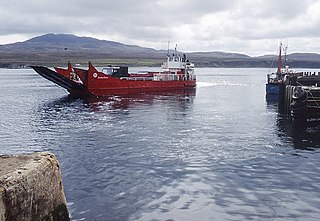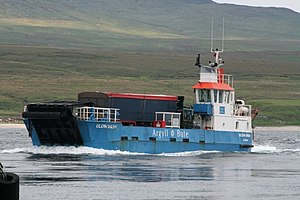
Caledonian MacBrayne, in short form CalMac, is the trade name of CalMac Ferries Ltd, the major operator of passenger and vehicle ferries to the west coast of Scotland, serving ports on the mainland and 22 of the major islands. It is a subsidiary of holding company David MacBrayne, which is owned by the Scottish Government.

Western Ferries (Clyde) Ltd is a private ferry company with its headquarters in Hunters Quay, Scotland. It currently operates on the Firth of Clyde running a year-round, high-frequency vehicle carrying service between Hunters Quay, near Dunoon, and McInroy's Point, on the outskirts of Gourock in Inverclyde.

The Caledonian MacBrayne fleet is the largest fleet of car and passenger ferries in the United Kingdom, with 35 ferries in operation, with one, MV Glen Sannox, currently undergoing crew familiarisation and harbour berthing trials ahead of being introduced into service. A further 5 vessels are currently under construction for the fleet. The company provides lifeline services to 23 islands off the west coast of Scotland, as well as operating routes in the Firth of Clyde.

MV Lord of the Isles is one of the larger Caledonian MacBrayne vessels, and operates from Mallaig on the west of Scotland. Built in Port Glasgow, she is the most-travelled vessel in the CalMac fleet.

MV Hebrides is a ferry operated by Caledonian MacBrayne from Uig to Lochmaddy and Tarbert, the main settlements of North Uist and Harris respectively.

MV Hebridean Isles was a ro-ro vehicle ferry that was operated by Caledonian MacBrayne on the west coast of Scotland. She was the first MacBrayne vessel to be ordered and built for them outside Scotland and the first to be launched sideways. With bow, stern and side ramps, Hebridean Isles was suitable for all the routes served by the large fleet units. After 15 years crossing the Little Minch on the Uig triangle, she served Islay and Colonsay before being retired in November 2024, after almost 40 years of service.

MV Isle of Arran is a drive-through ferry operated on the west coast of Scotland by Caledonian MacBrayne. Also known by her local nicknames IOA and The Auld Trooper, she entered service in 1984 on the Ardrossan to Brodick route, serving Arran for nine years before being moved to Kennacraig. She returned to her original route in 2012, supplementing MV Caledonian Isles in summer and becoming a relief vessel for Arran in winter as well as other routes where required. In 2013, she started a new pilot route from Ardrossan to Campbeltown, which became a permanent fixture in 2015. As of 2023, she is one of the oldest vessels in the fleet, having been in service for 40 years; upon arriving into Oban in the West Highlands, celebrations were mounted ashore to mark the 40th anniversary of her launch and service on 2 December 2023.

MV Jupiter was a passenger and vehicle ferry in the fleet of Caledonian MacBrayne in the Firth of Clyde, Scotland. She was the oldest of three "streakers" and the third River Clyde ship to bear the name 'Jupiter'. Her open car deck was accessible by stern and side ramps ro-ro. She entered service in 1974, and operated the Gourock to Dunoon crossing for much of her career. In 2006, she became the oldest vessel in the CalMac fleet and continued in service with them until 2010. Jupiter was sold for breaking in 2011.

West Loch Tarbert is a long, narrow sea loch on the western side of the Kintyre Peninsula, in Argyll and Bute, west of Scotland.

MV Pioneer is a stern / side loading ferry built in 1974, in service for 29 years covering nearly all of Caledonian MacBrayne's routes. She now serves the islands of São Tomé and Príncipe in the Gulf of Guinea and was chartered to rescue Liberian refugees.

MV Orion is a ro-ro passenger and vehicle ferry. Saturn was operated by Caledonian MacBrayne in the Firth of Clyde in Scotland between 1978 and 2011, for the first decade of her career on the Rothesay crossing. Later, she also saw service on the Dunoon and Brodick crossings, as well as on short cruises around the Clyde.

MV Juno was a passenger and vehicle ferry operated by Caledonian MacBrayne on the Firth of Clyde, Scotland between 1974 and 2007. She was the middle of three vessels nicknamed "streakers", the first in the Calmac fleet to be fitted with Voith Schneider Propellers. Juno left service in early 2007 and was laid up at Rosneath for 4 years. On 18 May 2011, she was beached there for scrapping and was gone by the end of July.

MV Finlaggan is a drive-through vehicle and passenger ferry built in Poland for Caledonian Maritime Assets Limited. From 2011, she has been operated by Caledonian MacBrayne on the Islay service from Kennacraig.
MV Maid of Cumbrae was a British passenger ferry operated by Caledonian Steam Packet Company from 1953. In the face of the car ferry revolution, in 1972, she was converted to a 15-car ferry for the Dunoon to Gourock crossing. Sold to Italian owners in 1978, she operated, as Capri Express in the Bay of Naples until 2006, when she was scrapped.

MV Arran was a pioneering Firth of Clyde vehicle ferry introduced by Caledonian Steam Packet Company in 1953. She spent fifteen years on the Upper Clyde crossings, followed by five years at Islay. Initially hoist-loading, via side ramps, these were replaced by a stern ramp in 1973. During her final years with CalMac, she relieved across the network. Several unsuccessful attempts were made to turn her into a floating restaurant, before she was scrapped in 1993.

David MacBrayne is a limited company owned by the Scottish Government. Formed in 1851 as the private shipping company David Hutcheson & Co. with three partners, David Hutcheson, Alexander Hutcheson and David MacBrayne, it passed in 1878 to David MacBrayne.

Caledonian Maritime Assets Limited owns the ferries, ports, harbours and infrastructure for the ferry services serving the west coast of Scotland, the Firth of Clyde and the Northern Isles.

MV Sound of Gigha was a pioneering roll-on/roll-off (ro-ro) ferry operating on the west coast of Scotland. She was launched as Isle of Gigha in May 1966. On 11 November 1966, she capsized off Islay. Salvaged, overhauled, and renamed, she provided thirty years of service between Islay and Jura.

MV Rhum is a car ferry built for Caledonian MacBrayne in 1974. Until 1987, she operated the seasonal Lochranza crossing to Arran. Since 1998, she has been one of the Arranmore ferries in County Donegal.

MV Sound of Jura was the first drive-through car ferry on the west coast of Scotland. It was operated by Western Ferries on the Islay service from Kennacraig between 1969 and 1976. The Mexican Government operated it to Cozumel as Quintana Roo until 2005, when it was wrecked by Hurricane Wilma.



















